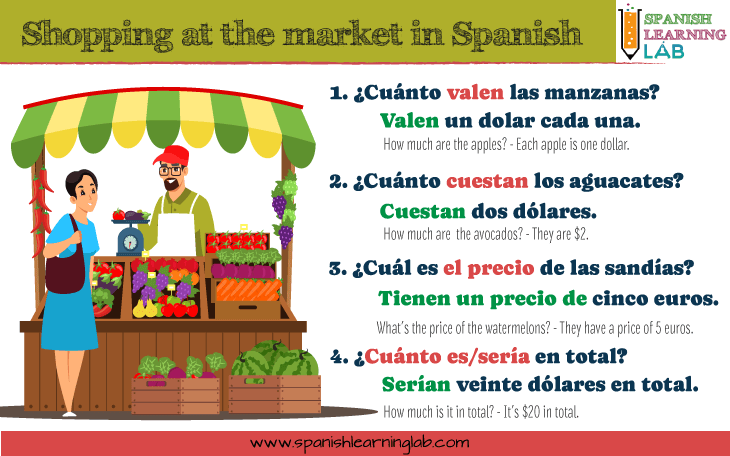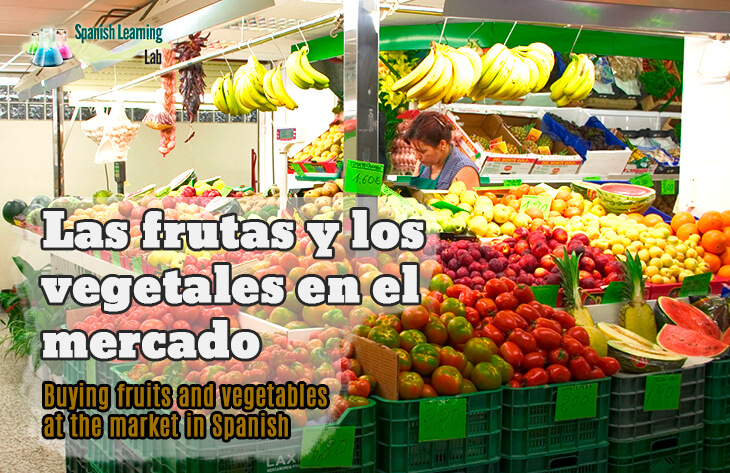Shopping groceries at a supermarket or market in Spanish is very simple, yet a very important topic to learn about especially when visiting Spanish-speaking countries. This lesson will focus on introducing the vocabulary for fruits and vegetables in Spanish, as well as some very useful phrases for buying groceries through several mini conversations and a nice video. In addition, we have included two listening activities and interactive quizzes to practice. Let’s start…
Vocabulary Intro: A list of Fruits and vegetables in Spanish
We will start the lesson by learning the vocabulary for common fruits and vegetables in Spanish through a short video. Most of the words in the video will be used in sample conversations at a market in Spanish. Do not worry if you cannot remember every single detail in the video and activate the subtitles if needed. Try to stick until the end so you can understand the conversations easily.
Talking about Fruits and Vegetables in Spanish
As shown in the video, there are lots words for fruits and vegetables in Spanish. Sometimes the names of some fruits will vary from country to country like “calala” and “maracuyá” for passion fruit. Generally speaking, we will use definite articles like [El, La, Los, Las] before the names of fruits and vegetables in Spanish, mainly when they play the subject of the sentence and not the object of a verb. For example, in the sentence “Las manzanas son deliciosas”, “LAS MANZANAS” is the subject, whereas in “Me gusta comer manzanas” the word “manzanas” is the object of the verb COMER, so there is no need to say “Las manzanas”.
As we have discussed in previous lessons, the verb SER (to be) will be used in its forms ES and SON plus adjectives to describe things in the language. Also, remember that GUSTAR for likes and dislikes will be accompanied by a direct object pronoun -most likely as “ME GUSTA” – following the structure [Object pronoun + gustar (conjugated) + activity or thing]. That being said, you can say what fruits and vegetables in Spanish you like this “Me gustan las fresas” or “Me gusta comer fresas“.
Here are two sample conversations about fruits and vegetables in Spanish including the phrases we have explained so far and few others. Click on play to listen to the examples.
Example No. 1
- Karla: ¡Qué frutas tan deliciosas! ¿Quieres una?
- Victor: Si, regálame una… mmm, en realidad están deliciosas. Me gustan mucho las naranjas y las sandías. ¿Cuáles son tus frutas favoritas?
- Karla: Me gustan las piñas, las papayas, las manzanas, las uvas… creo que me gustan todas.
- Victor: Así veo
Example No. 2
- Karla: ¿Te gusta comer vegetales?
- Victor: Si claro. Mis vegetales favoritos son el brócoli, la cebolla, el chile y la papa ¿A ti te gustan?
- Karla: Si, pero mis favoritos son otros… A mí me gustan el repollo, la zanahoria, la lechuga, la remolacha y el tomate…
- Victor: Sabes, no me gusta el ajo
- Karla: Pues a mí no me gusta la calabaza
Asking prices and Buying groceries at the market in Spanish
Asking prices at the market in Spanish
Now, let’s focus on the buying groceries at the market in Spanish part. Shopping can be translated as COMPRAR, so when you go to the market (al mercado) you go to COMPRAR PRODUCTOS (buy groceries in Spanish). In a market, the vendor (el vendedor) will usually offer the clients (los clientes) some products. You will also have the chance to ask for prices (pedir precios), quantities (cantidades) or for other products available.

The most common questions to ask for prices at the market in Spanish are: ¿Cuánto vale(n) + producto? y ¿Cuánto cuesta (n) + producto?, for example: ¿Cuánto vale una piña? and ¿Cuánto cuestan las cebollas? The vendor usually answers with “Vale (n) / Cuesta (n) + a price” this way: “Vale 1 dólar”. When talking about fruits and vegetables in Spanish, the vendor may say something like “El brócoli vale 1 dólar y las uvas 2 dólares“. Notice that VALER is only used once in the last sentences, although you can add it after “las uvas” as well. Lastly, to ask for the total price of the groceries you are buying in Spanish, you may use ¿Cuánto es en total? and ¿Cuánto es por todo?
Buying specific products and quantities in Spanish
To ask the vendor if she/he has a specific product, you may use the question ¿Tiene + product (s)? like this: ¿Tiene manzanas? When buying groceries at the market in Spanish, it is really important to be polite too, so that you can get good deals. You can ask the shop owner to sell you something politely with ¿Me puede vender + productos? as in the question “¿Me puede vender dos lechugas?”.
You will always need numbers and units of measurement (las unidades de medida) like kilo, libra (a pound), una bolsa (a bag), una docena (a dozen), media docena (half a dozen). These words are very useful to talk about quantities in Spanish, for instance: “Quiero una docena de fresas” (I want a dozen strawberries). Here are few more sample conversations including the vocabulary for fruits and vegetables in Spanish presented in the video plus some new expressions and questions used at the market in Spanish.
Example No. 3
- Karla: ¡Buenos días! ¿Tiene mangos?
- Vendedor: Si ¿Cuántos quiere?
- Vendedor: Es 1 dólar por los 6 mangos
- Karla: De acuerdo. Aquí tiene. ¡Gracias!
- Karla: Quiero 6 por favor. ¿Cuánto valen?
Example No. 4
- Karla: ¡Hola! ¿Me puede vender un melón, una piña, seis naranjas y una bolsa pequeña de fresas?
- Vendedor: Está bien…. Aquí tiene. Son 3 dólares en total. También tenemos vegetales…
- Karla: Bueno, entonces véndame un repollo, un kilo de cebollas, dos kilos de tomates y media docena de pepinos.
- Vendedor: Con mucho gusto…
- Karla: ¿Cuánto es en total?
- Vendedor: Son 3 dólares de las frutas más 3 de los vegetales… En total son 6 dólares.
- Karla: Muy bien, gracias
Example No. 5
- Karla: ¡Buenas tardes! ¿Cuánto cuestan el racimo de uvas y las papayas?
- Vendedor: Las papayas cuestan $0.50 cada una y el racimo de uvas cuesta $0.25.
- Karla: Bien, entonces deme una papaya y dos racimos de uvas. ¿Es 1 dólar verdad?
- Vendedor: Si, así es
- Karla: ¡Gracias!
- Vendedor: ¡Que le vaya bien!
Listening Activity No.1: Buying groceries at the market in Spanish

Key expressions in the dialogue:
- De todo un poco means “A little bit of everything”
- Me parece bien el precio means “The price sounds good to me”
Listening Activity No.2: Shopping at the market in Spanish
To finish the lesson, we would like you to practice with another Spanish listening activity, this time focusing on the core phrases and questions in this lesson. We hope you enjoyed learning about fruits and vegetables (frutas y vegetales) and that you truly understand how to ask for prices and product quantities at the market in Spanish. Anyway, you are always welcome to return and check this and other lessons. ¡Hasta pronto!
Related Spanish Worksheets:
- Fruits and vegetables in Spanish – PDF Worksheet
- Fruits and Vegetables in Spanish – PDF Crossword Puzzle
- Food in Spanish: conversation cards – PDF worksheet
- Shopping at the market in Spanish – PDF Worksheet
